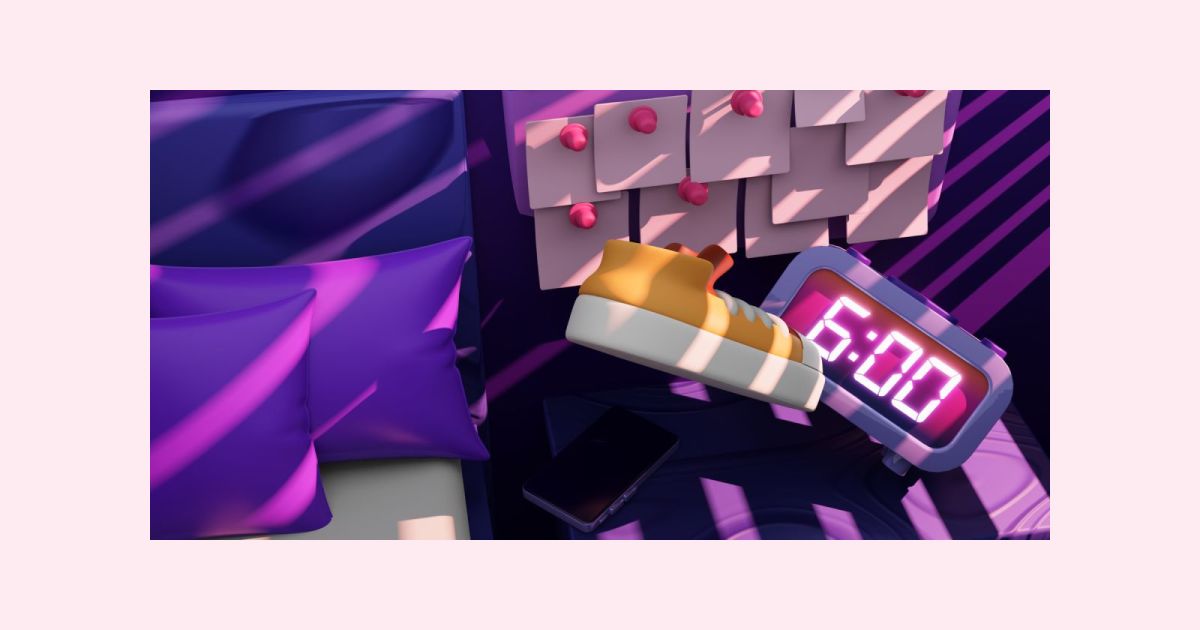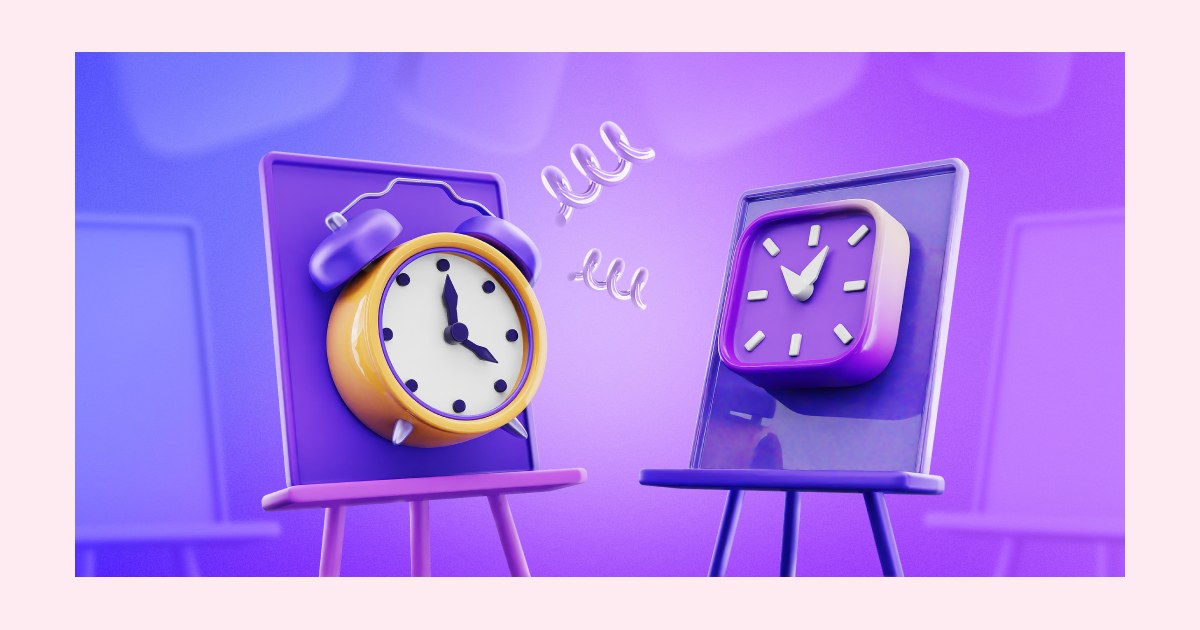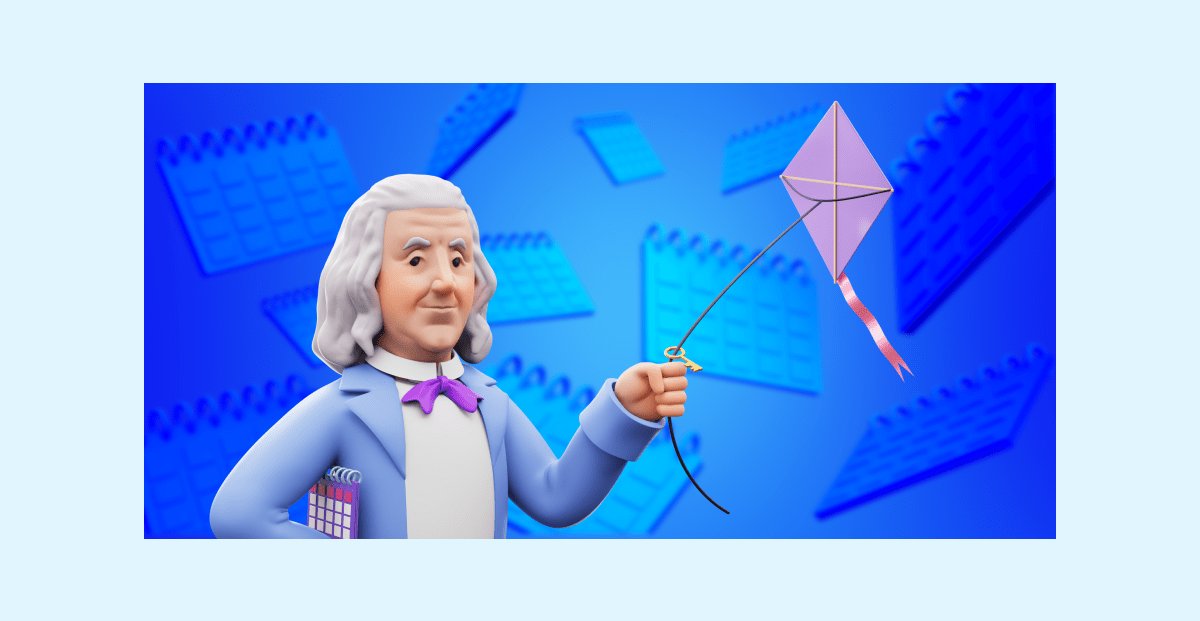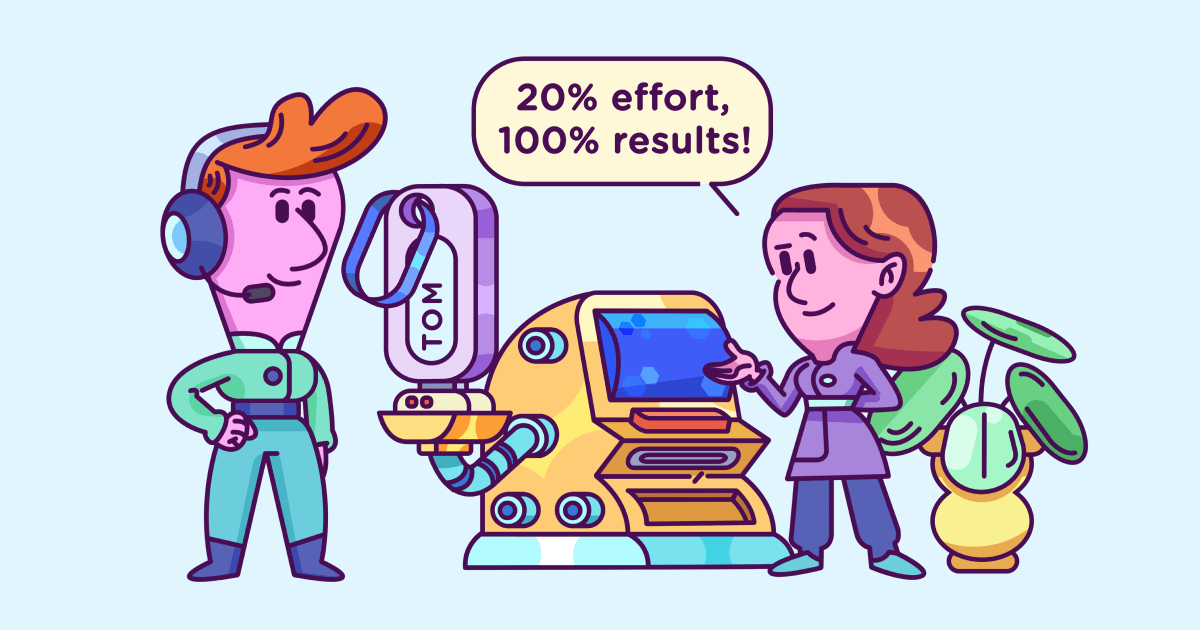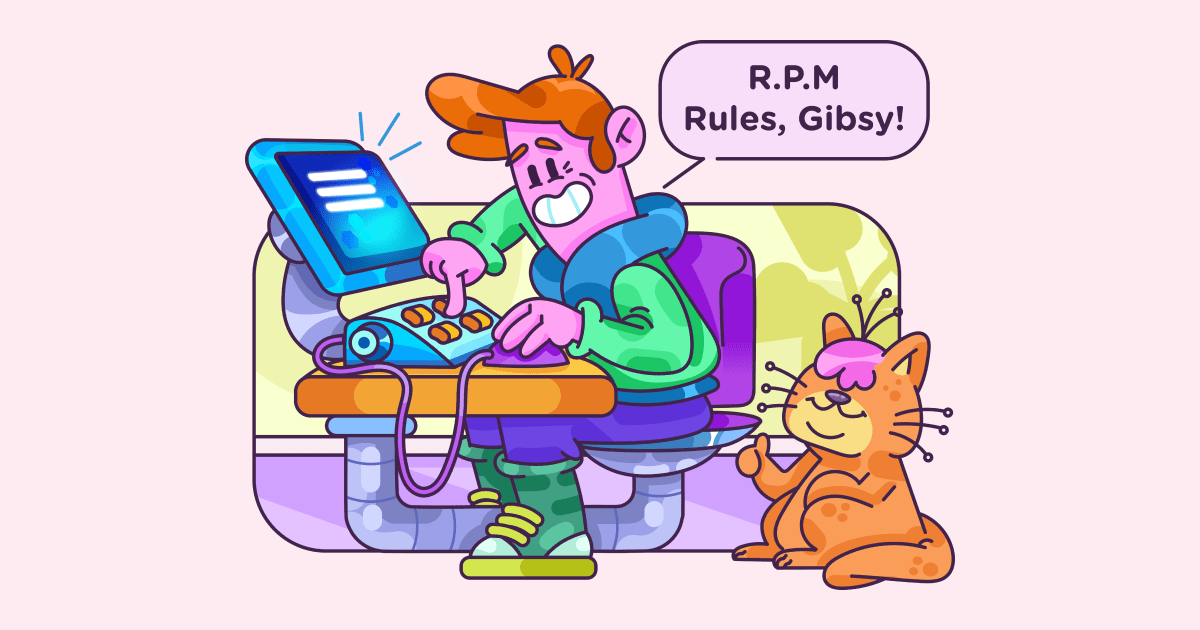Analysis paralysis, why it kills productivity and how to overcome it
Last updated on: May 5, 2023
Analysis paralysis is a sneaky productivity killer. It’s not widely discussed in the mainstream media, because we often believe the more information we have about something, the better we can decide on something. When in reality, most of the time we become paralyzed to the point of giving up.
In this article, we will discuss what analysis paralysis is, how it affects your productivity, and practical tips to avoid getting consumed by it.
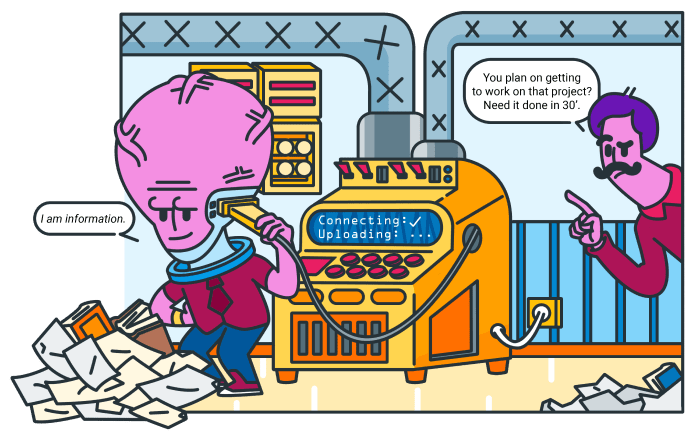
Table of Contents
What is analysis paralysis?
Analysis paralysis is what happens to me every once in a while, when I try to look for a habit-tracking app.
I’ll open the app store and start browsing. All I know is that I want an easy-to-follow, simple, colorful app that will make me want to check in every day and mark my tasks as done. Something to give me a sense of accomplishment, like Duolingo, for example.
That shouldn’t be too hard to find, right?
Except, whenever I start looking for one, I end up analyzing every single detail and being unable to decide which app would be best for me. Turns out, I can successfully find something wrong with every app I look at. And in the end, I simply close the app store and decide to deal with the choice another day.
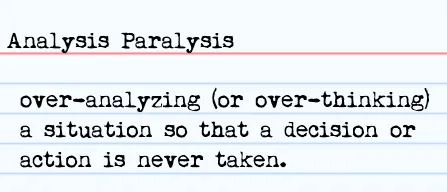
Image: civilengineeringcentral.com
The same may have applied to you with, for example, choosing a home appliance, a computer monitor (or other components), which bank to join, what preschool to get your kid in, or even where to go to dinner.
What does analysis paralysis look like?
In my case, of finding the best app, I’ve noticed it’s always the same cycle:
- I find an app in the search results
- I go through the screenshots to look at the UI and some of the options
- I look at the reviews
- I re-read the reviews, this time starting with the lowest scores
(because I NEED to see the possible bugs and downsides)
- I decide to go back on it if I don’t find anything better
- Keep browsing until I find another app
- Rinse and repeat
And 20 minutes to half an hour later, I close the app store and say I’ll deal with it another day.
Analysis paralysis is all around us
Barry Schwartz did an amazing (and still relevant, a whopping 13 years later!) TED talk on analysis paralysis. Or as worder id: the paradox of choice.
He argues that we’re more prone to this modern disease because our lives have become overindulgent in choices. Different types of branded food, clothes, electronics, vacation destinations… And when faced with such an overwhelming number, it ironically becomes more difficult to decide on only one. THere’s always the impression we’ll make a wrong choice.
When does analysis paralysis happen?
Analysis paralysis occurs when we are unsure what would be the best possible choice. Of course, we want the most favorable outcome to a problem or a task. Because we feel the decision holds a certain weight, it’s all the more important to choose the right thing. And when we can’t figure out what is the best decision, our mind grinds to a halt.
Ann Langley, a professor in the department of administrative science from Montreal wrote an interesting paper on analysis paralysis. She observed different companies, and situations where their project pipeline was affected by analysis paralysis. Specific triggers for these situations included:
- Collecting more data to convince upper management to take a certain route;
- Internal conflict where parties representing different methods tried to sway the rest of the team to their side (as Langley illustrates: one person finds data to block another, then the other finds data to unblock the block, and it keeps going in circles);
- Believing a certain aspect of the project is more important than it was;
- Person(s) are too deep into overanalysis, and can’t look at the data objectively anymore.
Her findings, while fascinating and definitely useful, were mainly reflecting the workplace as a whole. They illustrated analysis paralysis within a system, where more people are involved in the decision-making process.
But what happens when the same issue happens in an individual?
How analysis paralysis affects productivity
As mentioned, analysis paralysis makes it almost impossible to make a decision. Whether it’s about choosing how to sort your work emails, which software to use for a particular task, or how to assign tasks to team members.
First and foremost, when you get caught up in this “block”, you postpone important (or unimportant) decisions. This alone causes:
- Unnecessary drain on mental energy;
- Procrastination;
- Heightened sense of pressure, urgency and panic;
- Feelings of inadequacy;
- Fear of failure;
- Lower self-confidence;
And this is just some of the baggage that comes when we begin to overanalyze our choices. It quickly becomes clear how no normal person could become productive in such an environment.
While analysis paralysis may come from a good place – one where you want to make the most informed decision – it’s without a doubt one of the most debilitating things that can happen. And if not dealt with in time, this phenomenon can quickly become a very stressful way of life.
How to resolve analysis paralysis
The following tips are meant for moments when you notice all too late that you’ve succumbed to analysis paralysis. They are not methods for a long-term solution, but something you can do in that moment to get yourself out.
Remember what analysis should be used for
In the aforementioned paper, Langley starts by saying that analysis in itself is not a bad thing. It has its purpose. But once met with factors like uncertainty, fear of failure, upper management discord or indecisiveness, it turns into analysis paralysis.
She then outlines different reasons for analysis, as a reminder on why we do it in the first place. This means one can go back to this list before any analysis in the future, to keep themselves on track.
We conduct analysis for the following reasons:
- Information – Wanting to gather information in order to relieve uncertainty about a task. Data helps us look at the task or a problem and find the appropriate course of action, or to validate our assumptions.
- Communication – Using analysis to communicate our choices with others. Say, you want to show your team lead why you decided on route A instead of B, or writing up a report as a freelancer to your client.
- Direction and control – Langley explains this as a point where team leads, managers or CEOs ask their employees to perform an analysis in order to make an important decision. Such as testing the user base for a specific feature, or gathering information on the market about an aspect of the business.
- An act symbolism – A person could also decide to gather data because they want to show concern. For example, you’re not directly involved with a particular task, but you have a feeling that their course of action may cause more problems than solutions. So you gather data to show assertiveness and care about how the work is done.
Although these elements are a good reminder, Langley also argues that formal analysis can also be a waste of time. When it becomes politicised, used as a crutch, or a hurdle to purposefully obstruct a coworker we don’t like.
“Formal analysis would be less necessary if people could execute their decisions themselves and nobody had to convince anybody of anything. In fact, the more strategic decision-making power is shared among people who cannot quite trust each other, the more formal analysis may become important.” Ann Langley
So, you may find yourself overwhelmed with analysis paralysis in a team where coworkers don’t trust each other and have to provide evidence more often than not. Or when you don’t trust yourself enough, or are concerned your ideas and decisions need to be justified and backed with mountains of evidence.
Get a second pair of eyes
Most of the time, we get stuck in overanalyzing so much, it’s almost impossible to stand back and get an objective view of the situation.
Asking for help, whether from a coworker, a team lead, or someone you trust can dig you out of that hole. See if they can do a small research of their own, present them with the condensed data, or simply look for advice on how they would handle that particular information overload.
Find a compromise
Compromising is when you try to find a middle ground between two conflicting, yet equally valid sides. A manager might try to find a middle ground between two employees adamant on the team using their method for a single task.
In much the same way, you can be the manager that finds a compromise between two different approaches.
If you’ve wagered the pros and cons, and both methods (or tools, or approaches) seem valid to you, simply go with one, and find a way to use the other as a fallback option.
Ask yourself the following 4 questions
When all else fails, you might need to go back to the drawing board. Now, that doesn’t mean you need to drop the research completely and start anew. Because now, looking at the dilemma objectively is almost impossible.
What you need to do is minimize the damage, conserve energy and regroup. And you can get a better course of action by asking yourself these 4 questions:
- How important is this decision?
- Does the outcome of my decision affect anyone else further down the project development?
- Do I need to make this decision now? Can I sleep on it?
- Can my decision cause additional problems? How can I prevent this?
The first situation that comes to mind is when you’re faced with a “next-day” deadline. Think of a college student who knows they will most likely fail on a paper due tomorrow. They will almost instinctively start to think of different ways to compensate for the paper – ask for an extension, additional work to make up for lost points, calculate how many points they need on any future papers to guarantee a good final grade, etc.
How to prevent analysis paralysis
In this section, we’ll take a look at ways in which you can arm yourself to ensure analysis paralysis is rooted out of your life. Since “a stitch in time saves nine”, you will find that there are many more tips and tricks here than in the previous section.
Because analysis paralysis causes a lot of mental distress, confidence issues, career setbacks and stress, you’ll find most of these pieces of advice will address just that.
Learn to recognize it when it comes up
The best weapon in your armory is the ability to sense analysis paralysis before it rears its ugly head. According to Crystal Raypole of healthline.com, normally, when you need to make a decision, you will have a mental or literal list of several choices, and then narrow it down
Some indicators could be:
- Opening your 5th tab in Google because you don’t trust the other 4 sources are enough;
- A list of pros and cons longer than 5-10 items;
- Spending more than a day researching for smaller, less important decisions;
- Mulling over the data in your free time (obsessing over it).
Catching the rumination cycle much earlier will save you a lot of time. You’ll be able to stop and reconsider your next move – to get a second opinion, go with your gut feeling, or assess whether the decision is so important, it needs hours of research.
Limit your work time
Specifically, limit the amount of time you spend researching. Give yourself a deadline, a cut-off time when you will stop and make the decision. Unless you are willing to be strict with your work time, you will use any opportunity to look for more data or other options to handle a task.
Some ways in which you can schedule your research time:
- Start using time-blocking (we have a time blocking tutorial and free templates here);
- Break down your research into smaller segments and limit it to short intervals (15 minutes for each article, for example);
- Make use of a time blocking app;
- Do the research after the most important tasks
Researching could leave you mentally drained, leaving little to no energy for more important tasks.
Choosing when and for how long to research your options, resources and information conserves energy and helps your brain discipline itself into taking less time to mull over its choices.
Practice on smaller choices
If you find that indecisiveness is the biggest cause of analysis paralysis for you, then practicing how to make snap decisions in less intense situations can help. Or turn it into a game.
For example, pick a movie on your streaming service based on the thumbnail, and not the reviews. Or choose a take-out meal you’ve never tried, without looking up the ingredients (unless you have allergies, of course). Take a walk in your neighborhood on a random route, just let your feet carry you.
And while these examples can sound a little risky, they’re harmless enough to show you that the world doesn’t fall apart based on your decisions. You will survive a mediocre meal or a noisy boulevard. Let your brain get used to the fact that not everything can be calculated, and it’s fine.
Limit your resources
Sometimes, finding a reliable source can be a trigger for analysis paralysis. We get sucked in by the vast number of websites, and before long, we have over 10 tabs open and keep opening new ones to (in)validate a source.
Take the time to make a list of reputable websites you know you can trust. Ask among your coworkers as well. Bookmark and sort them, so that when you get started on a new task or project, you will spend less time wondering whether or not the information you find is credible.
Rate your decisions by importance
For those who treat all decisions equally, try rating them on a scale. That way you know which decisions need time and analysis, and which ones require snap reactions. Conserve your energy.
Make a list of everything that needs to be done that day (at work, at home, or both), and then give them a rating from 1 to 5. Treat tasks that score lower as something that should take you no more than a minute or two, and those that score higher as things that need a day (or more).
Odds are, not all tasks will be a 5 on a given day.
Align the decisions with your goals
Let’s say that you’re building a website. And you need to decide which front page layout works best.
You can spend days fiddling with options, screenshotting every single possibility, then getting feedback from friends, family, Reddit, Instagram… or, you could launch the website as is, and fix things as time goes by. It depends on whether:
- You need to launch the website as soon as possible, or
- You need to impress clients who are waiting on your portfolio.
Always keep your goals in mind. If your aim is to build an impressive portfolio, of course you will spend time and resources finding the best option. But if you have no client base, but wish to start as soon as possible, then there is no need to stall.
Get comfortable with uncertainty
Your mind needs to get used to the fact that you won’t be able to predict every outcome. If there are ten options to choose from, you would have to prepare for more than one possible outcome with every single one. And not only is it impossible, but it is also mentally straining, and a waste of time.
Make it a habit to ask yourself “what if…” as little as possible. Once you’ve eliminated an option, or decided against something, push it aside. Focus on the remaining choices.
Teach your brain that no matter what path you take, success is not guaranteed. You can only do your best at a given time.
Work on your confidence
As we’ve mentioned, analysis paralysis can cause (but can also be the result of) low self-esteem. When you don’t feel like your ideas hold water, that your opinion is valid, or that someone else has more credibility than you, data collecting is the only way you can get validation.
To avoid this trigger of analysis paralysis, work on your self-confidence. There are various methods for overcoming procrastination that push you into trusting yourself and your choices more. Trust yourself that you can handle any consequence that may come from a wrong choice, and you’ll slowly start to find it easier to make tough decisions without overthinking.
Stacey Barr’s 9 steps to avoid analysis paralysis
Stacey Barr, a performance measure specialist outlined a great guide on how to avoid analysis paralysis. When it comes to structuring your research process so you don’t trigger the vicious cycle of data collection, she advises breaking it down into 9 steps:
- Phrase the question
Formulate the question accurately and clearly. Write it down somewhere. We often lose the core question in the sea of information. So, keeping it in front of your eyes at all times will help you make focused effort.
- What kind of answer are you looking for? (to help choose the research method)
This determines the kind of research you want to do. Are you comparing two things? Are you making a list of all possible methods to tackle a task? Think about the form the answer will take, which can also help you narrow down the number of sources.
- What kind of analysis will you employ?
Barr says you should ask yourself – what kind of process do you need to go through to get the answer in the form you set up? Do you need a summary? A detailed report? A predictive analysis?
- What kind of data do you need?
For example, hours worked on a project, performance metrics, value ranges, etc. This helps you think in advance about how the data will be presented.
- Gather the data
- Sort the data and validate it
The previous step includes gathering the data without being too detailed yet. Only when you have all the resources available should you start checking for more in-depth mistakes. All the while, however, resisting the urge to go back to step 5. That step is done, and you can only move forward.
- Analyze
Apply the analysis based on the criteria you choose.
- Interpret the results
Summarize or explain the findings concisely. Make sure the information is clear and understandable, regardless if it’s for you, or someone else.
- Answer the question
Barr’s approach is of immense value to formal analyses in the workplace. However, with a few tweaks, you can adapt the steps to suit a more informal analysis. Such as choosing the best platform to use for project management.
In conclusion
Analysis paralysis is a very real problem, and one of the major causes for procrastination. Our productivity is impacted not just by the time wasted on research, but by our mental energy being drained, and our self-confidence plummeting. While there are ways to dig ourselves out of the overthinking cycle, the best method to combat this phenomenon is to work on being more mindful – researching smarter, limiting our time, getting used to uncertainty, and working on our self-confidence – just to name a few.
Since analysis paralysis can have different triggers, the solutions can vary as well. Make a conscious effort to find out what those triggers are for you, and you’re well on your way to make a fast recovery.
